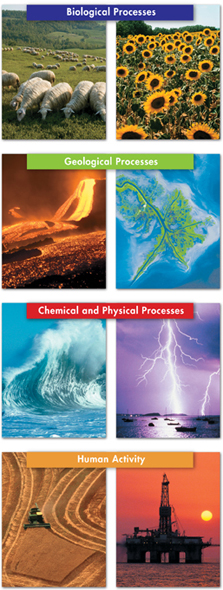There are many ways in which the processes involved in biogeochemical cycles can be classified. Here, we will use the following guidelines:
▸ Biological Processes Biological processes consist of any and all activities performed by living organisms. These processes include eating, breathing, “burning” food, and eliminating waste products.
▸ Geological Processes Geological processes include volcanic eruptions, the formation and breakdown of rock, and major movements of matter within and below the surface of the earth.
▸ Chemical and Physical Processes Chemical and physical processes include the formation of clouds and precipitation, the flow of running water, and the action of lightning.
▸ Human Activity Human activities that affect cycles of matter on a global scale include the mining and burning of fossil fuels, the clearing of land for building and farming, the burning of forests, and the manufacture and use of fertilizers.

Figure 3–14 Biogeochemical Processes Cycles of matter involve biological, geological, chemical, and human factors.
dThese processes, shown in Figure 3–14, pass the same atoms and molecules around again and again. Imagine, for a moment, that you are a carbon atom in a molecule of carbon dioxide that has just been shot out of a volcano. The leaf of a blueberry bush in a nearby mountain range absorbs you during photosynthesis. You become part of a carbohydrate molecule in a blueberry. A caribou eats the fruit, and within a few hours, you pass out of the animal's body. You are soon swallowed by a dung beetle, which gets eaten by a hungry shrew. You are combined into the body tissues of the shrew, which is then eaten by an owl. You are released back into the atmosphere when the owl exhales carbon dioxide, dissolve in a drop of rainwater, and flow through a river into the ocean.
This could just be part of the never-ending cycle of a carbon atom through the biosphere. Carbon atoms in your body may once have been part of a rock on the ocean floor, the tail of a dinosaur, or even part of a historical figure such as Julius Caesar!
Table of Contents
- Formulas and Equations
- Applying Formulas and Equations
- Mean, Median, and Mode
- Estimation
- Using Measurements in Calculations
- Effects of Measurement Errors
- Accuracy
- Precision
- Comparing Accuracy and Precision
- Significant Figures
- Calculating With Significant Figures
- Scientific Notation
- Calculating With Scientific Notation
- Dimensional Analysis
- Applying Dimensional Analysis




